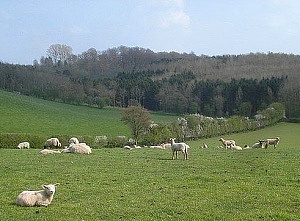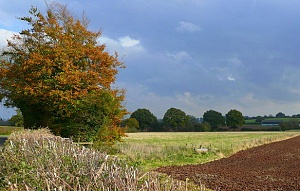Rous Lench

The parish of Rous Lench (or Rouse Lench), comprising the village of Rous Lench and the hamlet of Radford, is a rural parish of just over 100 homes situated to the north-west of Church Lench. The parish church is dedicated to St Peter.
The parish includes Rous Lench Court, an important 16th century court house originally occupied by the Rous (or Rouse) family. Very little remains of the original 16th century house: the building seen today dates from the second half of the 19th century when it was rebuilt in the Elizabethan style from the existing manor house. The house and gardens were restored at the end of the 20th century.

In the Domesday Book of 1086, Rous Lench was listed as "Biscopesleng", belonging to the abbey church of St Mary, Worcester, and assessed at 7 hides. During the next five centuries it was known under various forms of the name "Lench Randulf" before the name "Rous Lench" (or its alternative spellings "Rouse" or "Rowse") was widely adopted.
The manor of Rous Lench, together with land in the surrounding villages of Church Lench and Radford, was owned by the Rous family or their distant relatives the Boughton (later Rouse Boughton) family, from the late 14th century. The medieval moat that used to surround the manor house can still be seen in the grounds of Rous Lench Court. No trace of the house now remains, but the moat is classified as an ancient monument.
During the Civil War the Rous family were strong Parliamentarians. Oliver Cromwell is reputed to have dined at Rous Lench Court in 1651 on the eve of the Battle of Worcester, the final conflict of the Civil War. Richard Baxter, a 17th century writer and puritan minister who served as chaplain to a Parliamentary regiment, stayed at Rous Lench Court during the Civil War while recuperating from illness.

By the early 19th century the family estates included not only land in Rous Lench, Radford and Church Lench, but also at Ab Lench (described as "Abbots Lench or Hob Lench"). In 1876 Charles Henry Rouse Boughton sold Rous Lench Court and the estate to the Revd W.K.W. Chafy. Mr Chafy (later Dr. Chafy, after being awarded the degree of Doctor of Divinity) had already inherited land at Sheriffs Lench from his grandfather. Mr Chafy's surname is variously spelt as "Chafy" and "Chafy Chafy": the latter form arises because he "assumed the additional name of Chafy in pursuance of a too loosely worded claim in the will of his grandfather". The tenure of the Chafy family came to an end in 1926 when the estate was sold by Dr Chafy's son.

The occupants of the Court were generous benefactors to the village. In 1729 Elizabeth Rous, spinster of Rous Lench, left £100 in her will to the "poor of Rous Lench and Hob Lench" divided equally between the two parishes. Over 200 years later, Charles Henry Rouse-Boughton and his successor, Dr Chafy enlarged and improved the estate village by commissioning the village school (built in 1864, now a private house) and many new houses. Dr Chafy also commissioned the unusual letter boxes at Rous Lench and Radford.
Village website: www.rouslench.com
Radford


The name Radford is believed to derive from "Red Ford", referring to the red marl-coloured water in Piddle Brook running through the village. The village contains several black and white houses, and an ornate letterbox house which was commissioned by Dr Chafy of Rous Lench Court and bears his coat of arms. There used to be a water-driven corn mill on the brook, dating from the late 17th or early 18th century; this has now been converted into a private house.
The earliest mention of Radford appears to be during the 13th century; the village was included in a subsidy roll recording taxation in the final quarter of the century. Ownership of land at Radford frequently went in tandem with land at Rous Lench: by the early part of the 15th century much of the land at Radford appears to have been incorporated into the manor of Rous Lench.